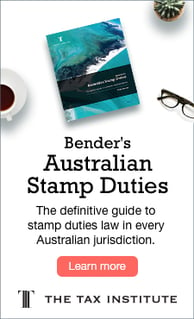Written by Bob Deutsch, CTA, Senior Tax Counsel
I wanted to take a closer look at an interesting recent case involving state stamp duty. The case is a decision of the High Court in Commissioner of State Revenue v Placer Dome Inc [2018] HCA 59 (the Placer Dome case).
Background
The facts in the Placer Dome case were straightforward. Barrick Gold Corporation (Barrick) announced a hostile, and ultimately successful takeover of another company called Placer Dome Inc (Placer) in 2005.
At all relevant times, the sole question for consideration was whether Barrick was liable for ad valorem stamp duty on the purchase of shares in Placer. This rested on whether Placer was (or was not) a “listed land-holder corporation”.
- If Placer was a “listed land-holder corporation” within the meaning of Div 3b of Part IIIBA of the Stamp Act 1921 (WA), Barrick was liable to pay ad valorem law duty in the amount of $54,852,300.
- If Placer was not a listed land-holder corporation, Barrick would be liable for no stamp duty whatsoever.
At the time, each state and territory had broadly similar stamp duty laws designed to ensure that if a company owns land beyond a certain stated percentage relative to all its assets and the shares in that company are purchased by a third party, stamp duty would be payable essentially as if the land itself had been acquired. This protects the state revenue by ensuring that stamp duty is not lost through using a corporate entity to house the land and then have the corporate entity sold. This is particularly necessary as generally the sale of shares in a company does not give rise to stamp duty.
Decision
The case went through three levels of decision making as follows:
- the WA State Administrative Tribunal found in favour of the WA Commissioner of State Revenue holding that Placer was a listed land-holder corporation;
- on appeal, the WA Court of Appeal took a different view ultimately remitting the matter back to the WA State Administrative Tribunal for determination in accordance with the Court of Appeal’s reasoning; and
- on further appeal, the High Court restored the decision of the WA State Administrative Tribunal.
The High Court’s decision comprises two separately written judgments. The joint decision of Kiefel CJ, Bell, Nettle, and Gordon JJ, and a separate decision written by Gageler J. The reasoning of Gageler J was different to the reasoning of the other four judges (called “the plurality”), but the conclusion in favour of restoring the decision of the WA State Administrative Tribunal was the same.
This led to an interesting question as to whether Placer had a material asset comprising legal goodwill.
What is goodwill for legal purposes?
The plurality held that goodwill for legal purposes, as distinct from accounting purposes, comprises only those sources which generated or added value or earnings to a business by attracting custom. Custom, they said, remained central to the concept of legal goodwill.
Barrick’s contention that goodwill for legal purposes was, or should be treated as synonymous with what it described as “the going concern value” was fundamentally rejected by the High Court.
By way of contrast, Gageler J appears to have accepted a broader concept of goodwill, embracing notions of going concern value.
If proven, the going concern value could be substantially greater than goodwill represented by custom alone. Accountants express the notion of goodwill essentially on the basis that it is the extra amount which a willing but not anxious buyer would be willing to pay for a group of business assets over and above the net value of the tangible assets being purchased. That is potentially a much larger amount than would arise under the legal concept of goodwill.
In the event however, Gageler J concluded that, “the extent to which a hypothetical purchaser would have attributed value to the assembled whole of Placer’s portfolio of goldmining and exploration tenements, was not explored in the evidence on which Barrick relied. That gap in the evidence is enough for the appeal to be decided in favour of the Commissioner.”
In other words, even though a broader concept was accepted by Gageler J, the result was the same as found by the plurality as Barrick had not established its case based on the evidence before the court.
Legal goodwill vs accounting goodwill
This issue as to the meaning of goodwill, and the contrast between the legal concept and the accounting concept has been explored in detail in papers written for The Tax Institute – see Goodwill and taxation issues - The Tax Specialist, Prof Michael Walpole, CTA.
Partly because of the complexities raised by this distinction between legal goodwill and accounting goodwill, all states and territories in Australia have now backed away from the land-rich land-holder concept, and instead, simply apply a rule that if the value of land exceeds a certain specified amount and the interest acquired exceeds a certain specified minimum, ad valorem duty will be payable. In other words, there is no requirement to compare the value of land to the value of total assets, thereby avoiding the goodwill issue discussed above.
To assist, my colleague Stephanie Caredes, Tax Counsel at The Tax Institute, has prepared the following table which outlines the relevant legislative sources and the requirement in each state and territory. It is worth noting that in the ACT and SA, there is no minimum threshold value required before ad valorem duty is attracted.
Landholder duty table
|
State
|
To be a landholder what is the minimum unencumbered value of land required to be held in the jurisdiction? |
What is a ‘significant interest’ (‘prescribed interest’ in SA) required in the landholder? |
What is the relevant legislative reference? |
|
ACT
|
None
|
Entitled to at least 50% of the property distributed
|
Chapter 3, Part 3.2 Duties Act 1999 (ACT)
|
|
NSW
|
$2,000,000
|
- Private – entitled to 50% or more of property
distributed
- Public – entitled to 90% or more of property distributed
|
Chapter 4 Duties Act 1997 (NSW)
|
|
NT
|
$500,000
|
- Unlisted entity - entitled to 50% or more of property
distributed
- Listed entity – entitled to 90% or more of property distributed (or 50% for merger vesting of shares) |
Part 3, Div 8A Stamp Duty Act (NT) (in force 1 July 2018)
|
|
QLD
|
$2,000,000
|
- Private – entitled to 50% or more of property
distributed
- Public – entitled to 90% or more of property distributed |
Chapter 3 Duties Act 2001 (QLD)
|
|
SA
|
None
|
- Private – has a proportionate interest of 50% or more
in the entity
- Public – has a proportionate interest of 90% or more in the entity |
Part 4, Stamp Duties Act 1923 (SA)
|
|
TAS
|
$500,000
|
- Private – entitled to 50% or more of property
distributed
- Public – entitled to 90% or more of property distributed
|
Chapter 3, Duties Act 2001 (TAS)
|
|
VIC
|
$1,000,000
|
- Private unit trust scheme – entitled to 20% or more of
property distributed
- Private company / wholesale unit trust scheme -
entitled to 50% or more of property distributed
- Listed company or public unit trust scheme - entitled to 90% or more of property distributed |
Chapter 3, Duties Act 2000 (VIC)
|
|
WA
|
$2,000,000
|
- Other landholder - 50% or greater entitlement to
surplus property on winding up
- Listed landholder – 90% or greater entitlement to surplus property on winding up |
Chapter 3, Duties Act 2008 (WA)
|
Going forward
The outcome in the Placer Dome case will nonetheless be important both for stamp duty cases and for the concept of goodwill going forward, which can be relevant in many other contexts as well.










